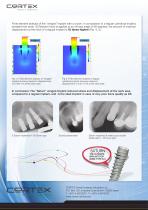
Catalog excerpts

"SATURN" The Ideal implant for D5 Bone Type Dr Zvi Laster D.M.D Surface roughness is an important factor in early osseointegration (Alberktsson et al). However, it is the macro-architectural design of the implant that establishes initial mechanical stability, which is crucial in minimizing implant mobility in the first 3-4 weeks of function. The quality of the bone for implantation at the posterior maxilla is usually very poor, (D4 or D5). In the case of D5 bone type, the bone is extremely porous therefore gaining sufficient initial stability is almost impossible. The new implant design, the “Saturn” dental implant (Cortex Dental Industries, Shlomi, Israel), employs a unique new strategy; that of extended sub-crestal threads, expanded outward in a wing-like effect to engage socket walls mid-crestally for added primary stability The implant is a grade 5 titanium conical screw with an internal hex, suitable for immediate function. Two 2.4mm spiral channels with a thickened reverse buttress thread extends around the implant for vertical and horizontal bone compaction. Anti-rotational resistance is built into the thread design, with a small platform switch for biological width. The tapered form with deep threads is particularly well suited for maxillary bone and immediate function Finite element analysis of the “winged” implant, in comparison to a regular implant, revealed that application of 20 Kg force is applied at an off-axis angle of 20 degrees generated 60% higher displacement at the neck area of a regular implant compared to the “winged” Saturn. (Fig.2,3). Fig-1: Finite element showing “winged” implant with maximum displacement of 5.2 Micron. Fig-2: Finite element showing regular cylindrical implant with maximum displacement of 8.5 Micron.
Open the catalog to page 1
Finite element analysis of the “winged” implant with a crown, in comparison to a regular cylindrical implant, revealed that when 80 Newton force is applied at an off-axis angle of 90 degrees, the amount of maximal displacement at the neck of a regular implant is 10 times higher! (Fig- 4, 5). Fig- 4: Finite element analysis of “winged” implant showing maximum displacement of 0.029 mm at the neck area. Fig-5: Finite element analysis of regular cylindrical implant showing maximum displacement of 0.214 mm at the neck area. In conclusion; The “Saturn” winged implant reduced stress and...
Open the catalog to page 2All Cortex-Dental Implants Industries catalogs and technical brochures
-
Product Catalogue 2015
25 Pages
-
Magix
2 Pages
-
Product Classification
1 Pages
-
Surgical Manual
37 Pages
-
Synthe-Bone
6 Pages
-
DRILL STOPPER KIT
1 Pages
Archived catalogs
-
NON-TOUCH PACKAGE
1 Pages











